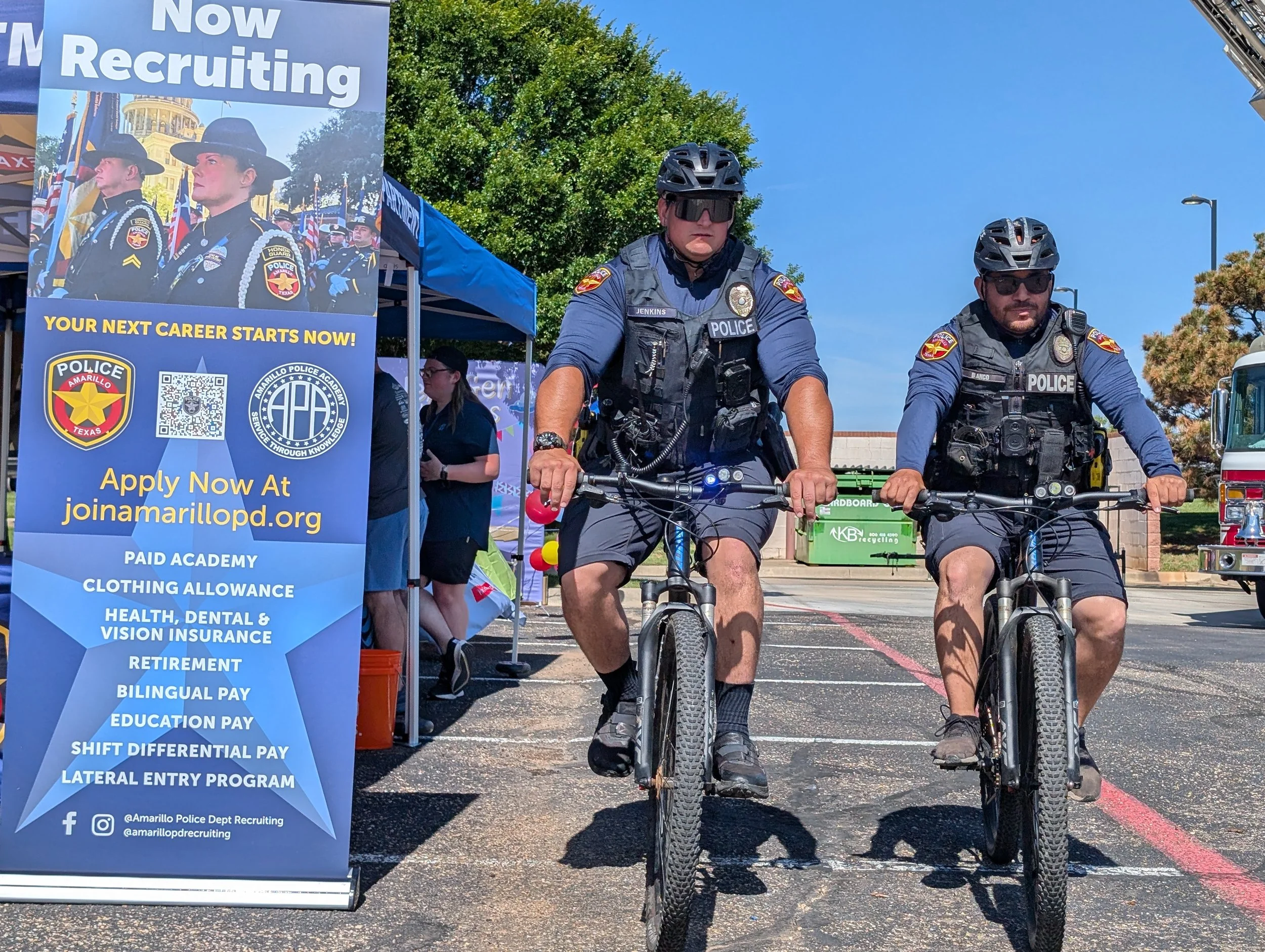Bike Patrol: Community Building on Two Wheels
As I adjusted the 20 pound bullet proof vest, I was grateful for the cooler spring weather. On a normal bike ride I would be trying to shed as much weight as possible. But this was not a normal ride. While I’ve participated in police ride-alongs before, this was my first time joining officers on a bicycle and the department’s first time hosting a civilian on a bike patrol. My cycling companions, Officers Blanco and Jenkins of the Amarillo Police Department, brought over 20 years of combined policing experience to our ride. As members of the Community Engagement unit, they take every opportunity to do their work on two wheels.
As the three of us pedaled through downtown, the officers greeted nearly everyone we passed. Sometimes it was a simple “Hello!” and a wave; other times, we stopped to chat with residents. It quickly became clear that on bikes, these officers weren’t just patrolling, they were actively participating with the community.
Community Building
The greatest value of bike patrols is their capacity for community building. Visibility and approachability are essential for trust, and nothing makes an officer more so than being out in the open, moving at the pace of the neighborhood. Unlike the distant, sometimes intimidating presence of a squad car, bike patrols place officers directly into the fabric of the community. There are no barriers of glass and steel, just a uniform, a bike, and a willingness to engage. This openness invites interaction.
Officer Jenkins noted that people are far more likely to approach, ask questions, or simply share a greeting when he’s on bike patrol. This was evident as our day led to many impromptu interactions, it was no wonder that he found himself out of stickers for the neighborhood kids. As community engagement officers, these casual interactions are perhaps the most important tool in their toolbox. These interactions, while seemingly small, have an outsized impact. They humanize the badge, turning “the police” into the friendly faces you see every week. Over time, these connections create a foundation of trust.
Shared Roads, Shared Challenges
What struck me most was how officers on bikes face the same daily realities as every other cyclist. Navigating traffic, watching for inattentive drivers, and struggling to find the safest route are universal experiences for anyone on two wheels. When asked if they felt safer on a bike while wearing a uniform than without, the answer was a simple “No.”
As a cycling advocate, I was disappointed by that response. Part of me hoped that bike officers had a secret to being seen in traffic. While their training certainly helps them navigate the roads as safely as possible, we all had to remain vigilant against the dangers posed by motor vehicles. Whether in uniform or form-fitting lycra, the truth remains, we all contend with the same hazardous environment.
Neighborhood Building
The benefits officers experience on bikes are not unique to law enforcement. Everyday cyclists, whether commuting or for recreation, enjoy many of the same advantages. Cycling offers a sense of freedom and connection that’s hard to replicate behind the wheel of a car. You notice the details, the neighbor’s blooming flowers, the shrills of children playing, the subtle shifts in the city’s mood from block to block.
Cycling also brings tangible health and environmental benefits. It’s exercise, transportation, and stress relief rolled into one. But perhaps most importantly, it’s a way to be present, to see and be seen, to interact with neighbors, to feel a part of something larger than yourself.
Reflections and Takeaways
My time riding with the police underscored a simple truth, our choice of transportation matters. When you’re on a bike you’re inhabiting a place, not just passing through. For officers, this means being more than just enforcers of the law, it means being a neighbor. For civilians, it means reclaiming a sense of belonging and agency in the city’s daily life.
While driving a vehicle, we are separated from our community by glass and metal, but on a bike, we’re part of it. This sentiment, echoed by officers and cyclists alike, captures the essence of what makes bicycle patrols and cycling in general so powerful. In a world that often feels disconnected, sometimes all it takes to build a bridge is two wheels and a willingness to say hello.
So whether you wear a badge or just a helmet, I invite you to enjoy the benefits of being on a bike and experience the joy of moving through your community at the speed of life.


